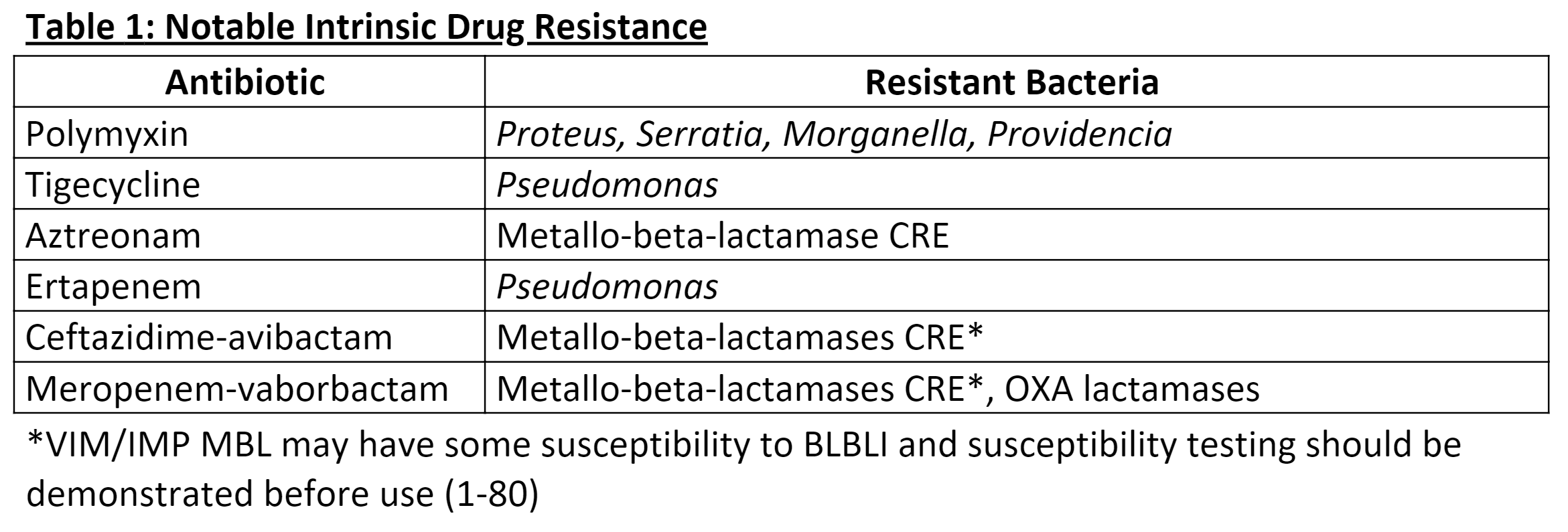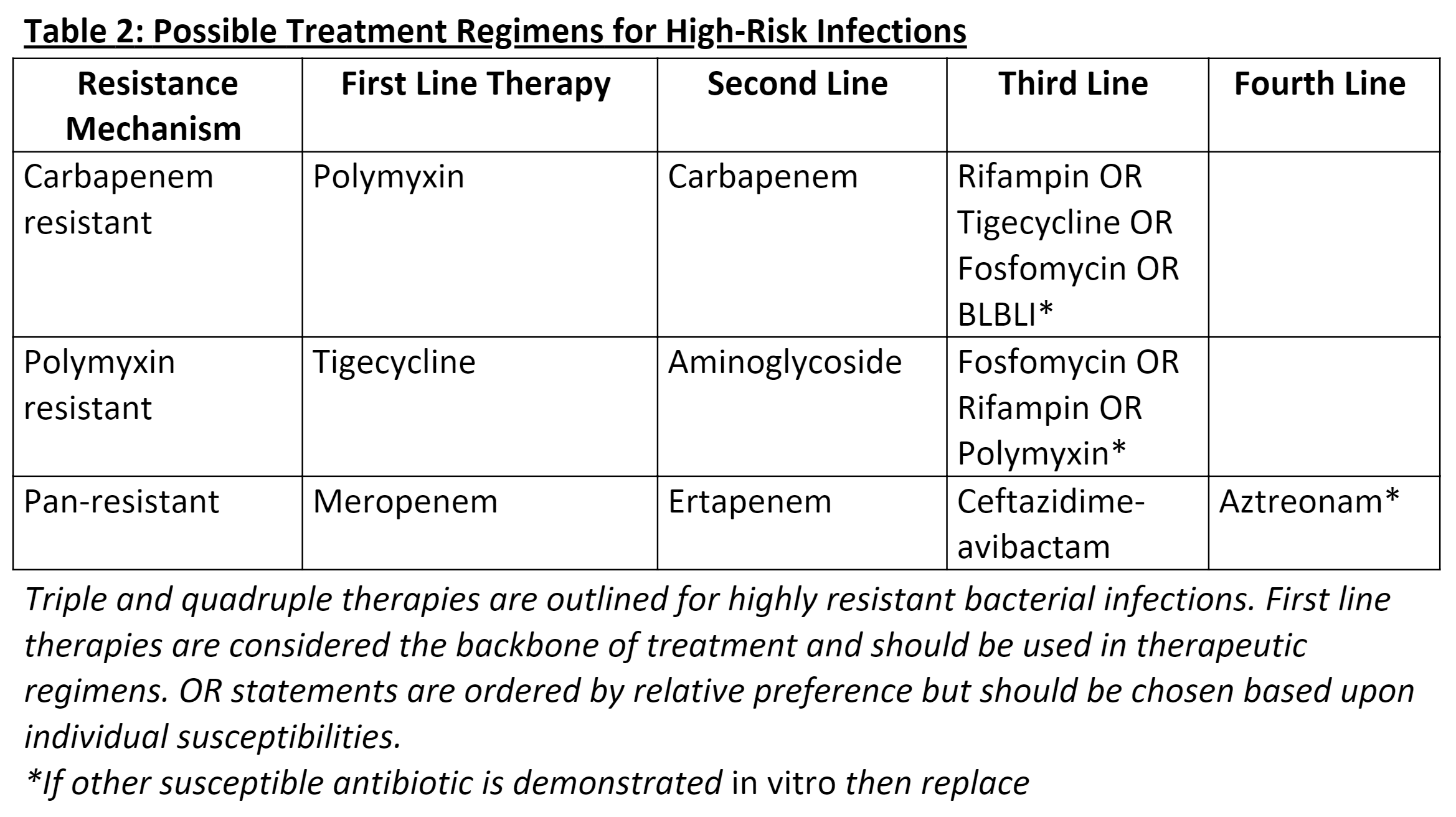[1]
Vardakas KZ,Tansarli GS,Rafailidis PI,Falagas ME, Carbapenems versus alternative antibiotics for the treatment of bacteraemia due to Enterobacteriaceae producing extended-spectrum β-lactamases: a systematic review and meta-analysis. The Journal of antimicrobial chemotherapy. 2012 Dec;
[PubMed PMID: 22915465]
Level 1 (high-level) evidence
[2]
Tzouvelekis LS,Markogiannakis A,Psichogiou M,Tassios PT,Daikos GL, Carbapenemases in Klebsiella pneumoniae and other Enterobacteriaceae: an evolving crisis of global dimensions. Clinical microbiology reviews. 2012 Oct;
[PubMed PMID: 23034326]
[3]
Munoz-Price LS,Poirel L,Bonomo RA,Schwaber MJ,Daikos GL,Cormican M,Cornaglia G,Garau J,Gniadkowski M,Hayden MK,Kumarasamy K,Livermore DM,Maya JJ,Nordmann P,Patel JB,Paterson DL,Pitout J,Villegas MV,Wang H,Woodford N,Quinn JP, Clinical epidemiology of the global expansion of Klebsiella pneumoniae carbapenemases. The Lancet. Infectious diseases. 2013 Sep;
[PubMed PMID: 23969216]
[4]
Codjoe FS,Donkor ES, Carbapenem Resistance: A Review. Medical sciences (Basel, Switzerland). 2017 Dec 21;
[PubMed PMID: 29267233]
[5]
Marsik FJ,Nambiar S, Review of carbapenemases and AmpC-beta lactamases. The Pediatric infectious disease journal. 2011 Dec;
[PubMed PMID: 22105420]
[6]
Perez F,Van Duin D, Carbapenem-resistant Enterobacteriaceae: a menace to our most vulnerable patients. Cleveland Clinic journal of medicine. 2013 Apr;
[PubMed PMID: 23547093]
[7]
Poirel L,Benouda A,Hays C,Nordmann P, Emergence of NDM-1-producing Klebsiella pneumoniae in Morocco. The Journal of antimicrobial chemotherapy. 2011 Dec;
[PubMed PMID: 21930570]
[8]
Arnold RS,Thom KA,Sharma S,Phillips M,Kristie Johnson J,Morgan DJ, Emergence of Klebsiella pneumoniae carbapenemase-producing bacteria. Southern medical journal. 2011 Jan;
[PubMed PMID: 21119555]
[9]
Franco MR,Caiaffa-Filho HH,Burattini MN,Rossi F, Metallo-beta-lactamases among imipenem-resistant Pseudomonas aeruginosa in a Brazilian university hospital. Clinics (Sao Paulo, Brazil). 2010;
[PubMed PMID: 21049207]
[10]
Sotgiu G,Are BM,Pesapane L,Palmieri A,Muresu N,Cossu A,Dettori M,Azara A,Mura II,Cocuzza C,Aliberti S,Piana A, Nosocomial transmission of carbapenem-resistant Klebsiella pneumoniae in an Italian university hospital: a molecular epidemiological study. The Journal of hospital infection. 2018 Aug;
[PubMed PMID: 29621600]
Level 2 (mid-level) evidence
[11]
Doumith M,Ellington MJ,Livermore DM,Woodford N, Molecular mechanisms disrupting porin expression in ertapenem-resistant Klebsiella and Enterobacter spp. clinical isolates from the UK. The Journal of antimicrobial chemotherapy. 2009 Apr;
[PubMed PMID: 19233898]
[12]
Sparbier K,Schubert S,Weller U,Boogen C,Kostrzewa M, Matrix-assisted laser desorption ionization-time of flight mass spectrometry-based functional assay for rapid detection of resistance against β-lactam antibiotics. Journal of clinical microbiology. 2012 Mar;
[PubMed PMID: 22205812]
[13]
Rodríguez-Baño J,Cisneros JM,Gudiol C,Martínez JA, Treatment of infections caused by carbapenemase-producing Enterobacteriaceae. Enfermedades infecciosas y microbiologia clinica. 2014 Dec;
[PubMed PMID: 25542052]
[14]
Lee J,Patel G,Huprikar S,Calfee DP,Jenkins SG, Decreased susceptibility to polymyxin B during treatment for carbapenem-resistant Klebsiella pneumoniae infection. Journal of clinical microbiology. 2009 May;
[PubMed PMID: 19261795]
[15]
Gomez-Simmonds A,Nelson B,Eiras DP,Loo A,Jenkins SG,Whittier S,Calfee DP,Satlin MJ,Kubin CJ,Furuya EY, Combination Regimens for Treatment of Carbapenem-Resistant Klebsiella pneumoniae Bloodstream Infections. Antimicrobial agents and chemotherapy. 2016 Jun;
[PubMed PMID: 27044555]
[16]
Lee GC,Burgess DS, Treatment of Klebsiella pneumoniae carbapenemase (KPC) infections: a review of published case series and case reports. Annals of clinical microbiology and antimicrobials. 2012 Dec 13;
[PubMed PMID: 23234297]
Level 2 (mid-level) evidence
[17]
Giannella M,Trecarichi EM,Giacobbe DR,De Rosa FG,Bassetti M,Bartoloni A,Bartoletti M,Losito AR,Del Bono V,Corcione S,Tedeschi S,Raffaelli F,Saffioti C,Spanu T,Rossolini GM,Marchese A,Ambretti S,Cauda R,Viscoli C,Lewis RE,Viale P,Tumbarello M, Effect of combination therapy containing a high-dose carbapenem on mortality in patients with carbapenem-resistant Klebsiella pneumoniae bloodstream infection. International journal of antimicrobial agents. 2018 Feb;
[PubMed PMID: 28842283]
[18]
Livermore DM,Warner M,Mushtaq S,Doumith M,Zhang J,Woodford N, What remains against carbapenem-resistant Enterobacteriaceae? Evaluation of chloramphenicol, ciprofloxacin, colistin, fosfomycin, minocycline, nitrofurantoin, temocillin and tigecycline. International journal of antimicrobial agents. 2011 May;
[PubMed PMID: 21429716]
[19]
Lee Y,Kim J,Trinh S, Meropenem-Vaborbactam (Vabomere{sup}™{/sup}): Another Option for Carbapenem-Resistant Enterobacteriaceae. P
[PubMed PMID: 30828230]
[20]
Rodríguez-Baño J,Gutiérrez-Gutiérrez B,Machuca I,Pascual A, Treatment of Infections Caused by Extended-Spectrum-Beta-Lactamase-, AmpC-, and Carbapenemase-Producing Enterobacteriaceae. Clinical microbiology reviews. 2018 Apr;
[PubMed PMID: 29444952]
[21]
Shiber S,Yahav D,Avni T,Leibovici L,Paul M, β-Lactam/β-lactamase inhibitors versus carbapenems for the treatment of sepsis: systematic review and meta-analysis of randomized controlled trials. The Journal of antimicrobial chemotherapy. 2015 Jan;
[PubMed PMID: 25261419]
Level 1 (high-level) evidence
[22]
Gutiérrez-Gutiérrez B,Salamanca E,de Cueto M,Hsueh PR,Viale P,Paño-Pardo JR,Venditti M,Tumbarello M,Daikos G,Cantón R,Doi Y,Tuon FF,Karaiskos I,Pérez-Nadales E,Schwaber MJ,Azap ÖK,Souli M,Roilides E,Pournaras S,Akova M,Pérez F,Bermejo J,Oliver A,Almela M,Lowman W,Almirante B,Bonomo RA,Carmeli Y,Paterson DL,Pascual A,Rodríguez-Baño J, Effect of appropriate combination therapy on mortality of patients with bloodstream infections due to carbapenemase-producing Enterobacteriaceae (INCREMENT): a retrospective cohort study. The Lancet. Infectious diseases. 2017 Jul;
[PubMed PMID: 28442293]
Level 2 (mid-level) evidence
[23]
Kelesidis T,Karageorgopoulos DE,Kelesidis I,Falagas ME, Tigecycline for the treatment of multidrug-resistant Enterobacteriaceae: a systematic review of the evidence from microbiological and clinical studies. The Journal of antimicrobial chemotherapy. 2008 Nov;
[PubMed PMID: 18676620]
Level 1 (high-level) evidence
[24]
van Duin D,Bonomo RA, Ceftazidime/Avibactam and Ceftolozane/Tazobactam: Second-generation β-Lactam/β-Lactamase Inhibitor Combinations. Clinical infectious diseases : an official publication of the Infectious Diseases Society of America. 2016 Jul 15
[PubMed PMID: 27098166]
[25]
Mazuski JE,Gasink LB,Armstrong J,Broadhurst H,Stone GG,Rank D,Llorens L,Newell P,Pachl J, Efficacy and Safety of Ceftazidime-Avibactam Plus Metronidazole Versus Meropenem in the Treatment of Complicated Intra-abdominal Infection: Results From a Randomized, Controlled, Double-Blind, Phase 3 Program. Clinical infectious diseases : an official publication of the Infectious Diseases Society of America. 2016 Jun 1;
[PubMed PMID: 26962078]
Level 1 (high-level) evidence
[26]
Huang D,Yu B,Diep JK,Sharma R,Dudley M,Monteiro J,Kaye KS,Pogue JM,Abboud CS,Rao GG, {i}In Vitro{/i} Assessment of Combined Polymyxin B and Minocycline Therapy against Klebsiella pneumoniae Carbapenemase (KPC)-Producing K. pneumoniae. Antimicrobial agents and chemotherapy. 2017 Jul;
[PubMed PMID: 28438930]
[28]
Doi Y,Wachino JI,Arakawa Y, Aminoglycoside Resistance: The Emergence of Acquired 16S Ribosomal RNA Methyltransferases. Infectious disease clinics of North America. 2016 Jun;
[PubMed PMID: 27208771]
[29]
Li JJ,Sheng ZK,Deng M,Bi S,Hu FS,Miao HF,Ji ZK,Sheng JF,Li LJ, Epidemic of Klebsiella pneumoniae ST11 clone coproducing KPC-2 and 16S rRNA methylase RmtB in a Chinese University Hospital. BMC infectious diseases. 2012 Dec 23;
[PubMed PMID: 23259910]
[30]
Karageorgopoulos DE,Miriagou V,Tzouvelekis LS,Spyridopoulou K,Daikos GL, Emergence of resistance to fosfomycin used as adjunct therapy in KPC Klebsiella pneumoniae bacteraemia: report of three cases. The Journal of antimicrobial chemotherapy. 2012 Nov;
[PubMed PMID: 22782489]
Level 3 (low-level) evidence
[31]
Both A,Büttner H,Huang J,Perbandt M,Belmar Campos C,Christner M,Maurer FP,Kluge S,König C,Aepfelbacher M,Wichmann D,Rohde H, Emergence of ceftazidime/avibactam non-susceptibility in an MDR Klebsiella pneumoniae isolate. The Journal of antimicrobial chemotherapy. 2017 Sep 1;
[PubMed PMID: 28637339]
[32]
Gniadek TJ,Carroll KC,Simner PJ, Carbapenem-Resistant Non-Glucose-Fermenting Gram-Negative Bacilli: the Missing Piece to the Puzzle. Journal of clinical microbiology. 2016 Jul;
[PubMed PMID: 26912753]


